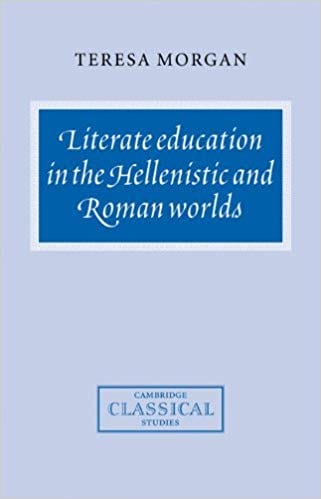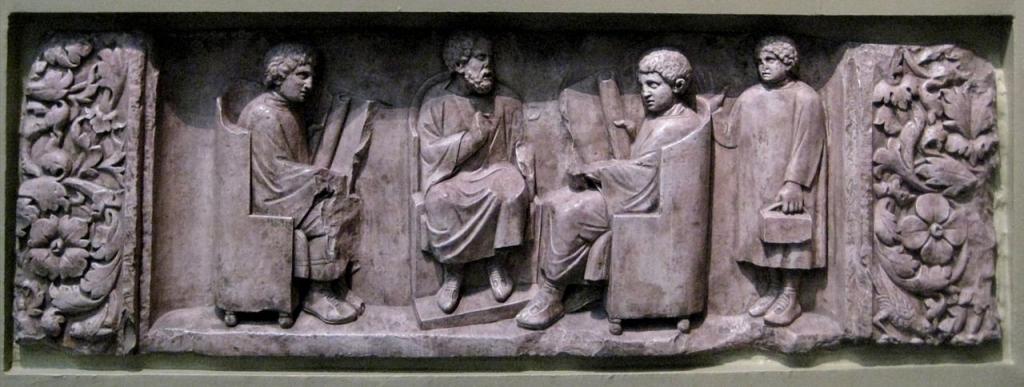One of the first impressions one gets from the background chapter is just how highly poetry was prized in antiquity, and how often it was the first thing that the young learned some of as part of their education, well before they read history, and long long before they read philosophy. This of course differs dramatically from most modern Western education, all too concerned with left brained studies and functions. For example, just for fun I recently took a much touted IQ test. The test consisted entirely of left brained sorts of analysis, tracing mathematical progressions and saying what would be next, studying shapes and saying which belong together, and so on. Nothing about history, nothing about foreign language or even English in general, nothing about the arts whatsoever, and I could go on. Not surprisingly, I tested out as above average for the left brained side of my head, but there was no evaluation of what I’m really good at. And certainly no testing of my understanding or ability to write poetry!! The ancients would have not approved of such a one half of the brain test. They would have wanted not only math, and geometry and the like included but also poetry, philosophy, rhetoric, and much else.
Another of the fascinating insights along the way is that education was not done by grade level or age of the pupil, although it appears to have begun properly when the child was seven. As various of the ancient writers say, including Quintilian each child should move ahead in their education at whatever age they have become fit to progress to the next steps (be it more literature, grammar, or even rhetoric). This meant that both young and older boys (and it was boys in the vast majority of cases) would be learning together, and Quintilian warns that the older boys must be kept in check and not allowed to ‘mess’ with the younger boys, physically or otherwise. Competition between the boys in class was actually encouraged.
Morgan confirms with direct citation that the key Greek word PAIDAGOGOS does not refer to a teacher but rather to an attendant or child minder, indeed the term is regularly contrasted with the word DIDASKALOS (see p. 17 and note 51, and p. 244 where the paidagogos is grouped with the nurse in the home as the first to help a child towards an educational process). This evidence frankly rulers out the notion that Paul in Gal. 4 is referring to a teacher when he uses the analogy between the Mosaic Law and the paidagogos. No, says Paul it is the child minder keeping GOD’S PEOPLE under wraps and on task, until Christ came. Here is an insightful description from the CGL inscriptions (III,639-40, 646) of the educational process as told by the pupil himself (p. 66 in Morgan)….
“I go to school, I have entered, I have said: ‘Greetings, Master” and he has kissed me and returned my greeting. My secretary/slave (i.e. the paidagogos) handed me the tablets, writing case, model, in my place I clean the [surface of the tablets– presumably the wax inserts in the tablets used for practice writing], I copy the model as instructed; as I have written, as I have written I show [my work] to the teacher; he has corrected it and smoothed it over; he orders me to read. After I have been ordered, I have given [the text] to another. I learn glosses, I have recited them. But immediately, a fellow pupil has dictated to me… while this is going on, the little boys go, on the teachers orders, to a separate place, and one of the [older] boys has provided syllables for them; others return in order to the assistant, and write names; they have written verses, and I have taken dictation in the first group. Then as we sit down I go through commentaries, language, the art of grammar. When I have been called to read [I then] listen to expositions of the reading, interpretations….”
The order then of education is learning the alphabet (and always Greek and its alphabet had pride of place, even in most places in the West), then learning syllables, then learning words, including names from Homer or Euripides, then learning sentences, maxims and composing them, then learning grammar, and then the rest. Note as well that reading is again and again done out loud, and so even the sounding out of the words is subject to a teacher’s correction. These are oral cultures, and the living voice is given primacy, and writing is used as tool for speaking, even when reading classics like Homer. Note that rhetorical exercises were not merely used to teach rhetoric, but already at the elementary level to teach ways of speaking and writing (p.197). It is a mistake to neglect how important rhetoric was to all levels of education. My main complaint about Morgan’s work is that she spends too little time in this study on rhetoric, and particularly on the de facto evidence of rhetoric’s use, even in sophisticated form by even non-elite persons from the Jewish tradition such as the author of Hebrews, or the composer of 1 Peter, or Luke. But this is of course the sort of critique I would have as a NT scholar, but that does not in any way diminish was a treasure trove of information and insight this study is about ancient education. I wish I had known about it 20 years ago.













